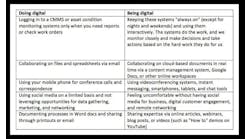By Sean Evoy, Wind River product line manager
Digital twin is an increasingly common term. Unfortunately, when the topic of digital twin comes up the conversation frequently turns to the challenges of implementation and
conclude in: Digital twins are too complicated. They are too complex to be effective for us.
And that’s fair. I understand why people might be reluctant to make the up-front investment of digital twin. But imagine the massive opportunities available with implementing digital twins as part of your solutions if you could overcome some of these challenges.
Let’s distill it down to its essence—a digital twin is really just a model of a real-world thing. Sure, that model can be enormously complicated, but it can also be very simple. And once you have a digital twin up and running—an analog version of a real-world thing—you can do some amazing things with it.
You can pre-stage updates. You can monitor your systems like never before. You can perform sophisticated and comprehensive testing that would be costly or impossible to perform with the physical hardware.
In short, a digital twin is a simple idea with a very powerful payoff.
Win digital twin
To fully grasp a digital twin in your environment, it helps to consider the drivers: what is the motivation to implement this tool? Your drivers to implement a digital twin should align with your larger business drivers. Technology for the sake of technology doesn’t benefit anybody.
One of the most common business drivers we see is using a digital twin to manage risk. Nobody wants to push an update to a device that either compromises operations or adds security vulnerabilities or, worse still, takes it out of commission and forces it to be re-issued. And let’s be honest, nobody wants a mistake they made to end up in the news.
Being able to pre-test and pre-deploy an update or a security patch on a digital twin before you make it available to a real-world system is a very powerful advantage. And there is an added benefit: the data that comes from these devices is actually a business asset, enabling you to improve your profitability and efficiency by monitoring and making sure the configuration and operations of systems is optimal, which allows you to pursue new lines of business and potentially monetize the data.
In addition, most people operate under some combination of safety, quality and/or legislative constraints. Having a digital twin helps you meet those standards more easily, in a strategic, standardized manner. There are huge cost-savings here, as well.
Mitigating complexity
In many cases, one of the greatest challenges that developers face when building digital systems is the complexity of the hardware at the core of it. (Sound familiar?) Having a digital twin creates a smoother path to the development of the next version of your application by reducing your dependence on those complex assets for the data they generate.
A digital representation, which delivers the same information as the actual hardware, is a streamlined path to getting those actionable insights. You can store and manage data with unprecedented access and accuracy. You can perform optimizations through root-cause analysis and study full data sets. Because it is a digital representation you are not bound by physical limitations, giving you a much greater degree of flexibility of what and how you test. Likewise, fully knowing the state of your assets allows you to reapply the normal state when they come back online after a disruption or shutdown.
And imagine being able to roll out a system for which you already have a digital twin. Speed is enhanced. Costs are reduced. Set configurations can be delivered to that physical device in the opposite direction—moving from the digital realm to the physical world courtesy of insights from a digital twin.
So why the reluctance to get started?
That’s a good question. Part of the problem is that it’s not always obvious to business owners exactly what kind of digital twin they need to build. Consider a car, which in the real world is, essentially, a rolling computer platform. As an automaker, you don’t really care about every piece of data, every system in the car. But the challenge is determining what systems warrant their own digital twin.
If one of the main data-generators you care about is the instrument cluster (you want the telematics data coming from it) a digital twin provides insight on the state of being and the ability to patch the IVI or entertainment systems. Then, scaling out efforts, perhaps you want to manage the state of one or more of the ECUs running on the car. Done!
Notice how we’ve very carefully pared down the model so that it only represents the things that are important. Frankly, this has been the single greatest challenge that people face when they begin to create digital models. Where do we stop?
The key is determining what you want to monitor and, then, doing so accurately. Mere data is not enough. You need a model of state and a model of behavior.
And remember, while model accuracy is critical to this whole approach, it is also double-edged sword. You must remove the data you don’t care about while precisely managing the data that is critical to your operations.
Selecting the right, complete solution to build an effective digital twin is critical to its success. Our Simics is that solution. Hopefully this article gave you some useful things to consider as you create and employ digital twins in your embedded solution.

